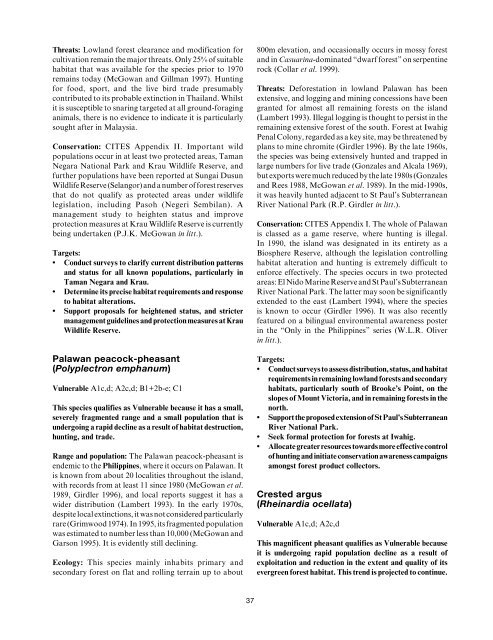Pheasants: Status Survey and Conservation Action Plan ... - IUCN
Pheasants: Status Survey and Conservation Action Plan ... - IUCN
Pheasants: Status Survey and Conservation Action Plan ... - IUCN
Create successful ePaper yourself
Turn your PDF publications into a flip-book with our unique Google optimized e-Paper software.
Threats: Lowl<strong>and</strong> forest clearance <strong>and</strong> modification for<br />
cultivation remain the major threats. Only 25% of suitable<br />
habitat that was available for the species prior to 1970<br />
remains today (McGowan <strong>and</strong> Gillman 1997). Hunting<br />
for food, sport, <strong>and</strong> the live bird trade presumably<br />
contributed to its probable extinction in Thail<strong>and</strong>. Whilst<br />
it is susceptible to snaring targeted at all ground-foraging<br />
animals, there is no evidence to indicate it is particularly<br />
sought after in Malaysia.<br />
<strong>Conservation</strong>: CITES Appendix II. Important wild<br />
populations occur in at least two protected areas, Taman<br />
Negara National Park <strong>and</strong> Krau Wildlife Reserve, <strong>and</strong><br />
further populations have been reported at Sungai Dusun<br />
Wildlife Reserve (Selangor) <strong>and</strong> a number of forest reserves<br />
that do not qualify as protected areas under wildlife<br />
legislation, including Pasoh (Negeri Sembilan). A<br />
management study to heighten status <strong>and</strong> improve<br />
protection measures at Krau Wildlife Reserve is currently<br />
being undertaken (P.J.K. McGowan in litt.).<br />
Targets:<br />
• Conduct surveys to clarify current distribution patterns<br />
<strong>and</strong> status for all known populations, particularly in<br />
Taman Negara <strong>and</strong> Krau.<br />
• Determine its precise habitat requirements <strong>and</strong> response<br />
to habitat alterations.<br />
• Support proposals for heightened status, <strong>and</strong> stricter<br />
management guidelines <strong>and</strong> protection measures at Krau<br />
Wildlife Reserve.<br />
Palawan peacock-pheasant<br />
(Polyplectron emphanum)<br />
Vulnerable A1c,d; A2c,d; B1+2b-e; C1<br />
This species qualifies as Vulnerable because it has a small,<br />
severely fragmented range <strong>and</strong> a small population that is<br />
undergoing a rapid decline as a result of habitat destruction,<br />
hunting, <strong>and</strong> trade.<br />
Range <strong>and</strong> population: The Palawan peacock-pheasant is<br />
endemic to the Philippines, where it occurs on Palawan. It<br />
is known from about 20 localities throughout the isl<strong>and</strong>,<br />
with records from at least 11 since 1980 (McGowan et al.<br />
1989, Girdler 1996), <strong>and</strong> local reports suggest it has a<br />
wider distribution (Lambert 1993). In the early 1970s,<br />
despite local extinctions, it was not considered particularly<br />
rare (Grimwood 1974). In 1995, its fragmented population<br />
was estimated to number less than 10,000 (McGowan <strong>and</strong><br />
Garson 1995). It is evidently still declining.<br />
Ecology: This species mainly inhabits primary <strong>and</strong><br />
secondary forest on flat <strong>and</strong> rolling terrain up to about<br />
800m elevation, <strong>and</strong> occasionally occurs in mossy forest<br />
<strong>and</strong> in Casuarina-dominated “dwarf forest” on serpentine<br />
rock (Collar et al. 1999).<br />
Threats: Deforestation in lowl<strong>and</strong> Palawan has been<br />
extensive, <strong>and</strong> logging <strong>and</strong> mining concessions have been<br />
granted for almost all remaining forests on the isl<strong>and</strong><br />
(Lambert 1993). Illegal logging is thought to persist in the<br />
remaining extensive forest of the south. Forest at Iwahig<br />
Penal Colony, regarded as a key site, may be threatened by<br />
plans to mine chromite (Girdler 1996). By the late 1960s,<br />
the species was being extensively hunted <strong>and</strong> trapped in<br />
large numbers for live trade (Gonzales <strong>and</strong> Alcala 1969),<br />
but exports were much reduced by the late 1980s (Gonzales<br />
<strong>and</strong> Rees 1988, McGowan et al. 1989). In the mid-1990s,<br />
it was heavily hunted adjacent to St Paul’s Subterranean<br />
River National Park (R.P. Girdler in litt.).<br />
<strong>Conservation</strong>: CITES Appendix I. The whole of Palawan<br />
is classed as a game reserve, where hunting is illegal.<br />
In 1990, the isl<strong>and</strong> was designated in its entirety as a<br />
Biosphere Reserve, although the legislation controlling<br />
habitat alteration <strong>and</strong> hunting is extremely difficult to<br />
enforce effectively. The species occurs in two protected<br />
areas: El Nido Marine Reserve <strong>and</strong> St Paul’s Subterranean<br />
River National Park. The latter may soon be significantly<br />
extended to the east (Lambert 1994), where the species<br />
is known to occur (Girdler 1996). It was also recently<br />
featured on a bilingual environmental awareness poster<br />
in the “Only in the Philippines” series (W.L.R. Oliver<br />
in litt.).<br />
Targets:<br />
• Conduct surveys to assess distribution, status, <strong>and</strong> habitat<br />
requirements in remaining lowl<strong>and</strong> forests <strong>and</strong> secondary<br />
habitats, particularly south of Brooke’s Point, on the<br />
slopes of Mount Victoria, <strong>and</strong> in remaining forests in the<br />
north.<br />
• Support the proposed extension of St Paul’s Subterranean<br />
River National Park.<br />
• Seek formal protection for forests at Iwahig.<br />
• Allocate greater resources towards more effective control<br />
of hunting <strong>and</strong> initiate conservation awareness campaigns<br />
amongst forest product collectors.<br />
Crested argus<br />
(Rheinardia ocellata)<br />
Vulnerable A1c,d; A2c,d<br />
This magnificent pheasant qualifies as Vulnerable because<br />
it is undergoing rapid population decline as a result of<br />
exploitation <strong>and</strong> reduction in the extent <strong>and</strong> quality of its<br />
evergreen forest habitat. This trend is projected to continue.<br />
37
















